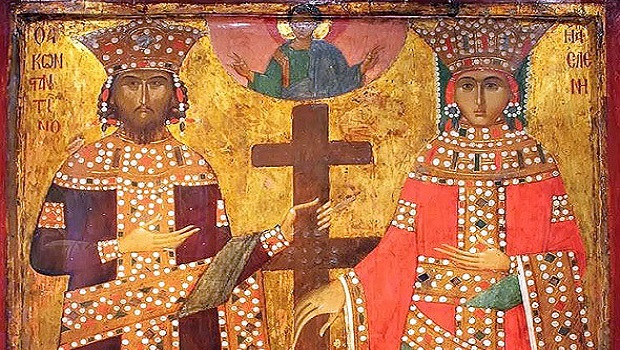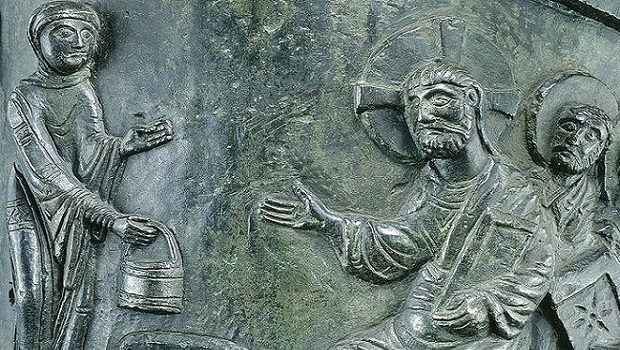Martyr Anastasius
A Saint of this name is commemorated on December 5, in the Martyrologies, but neither the place nor the time of his passion is discoverable. When he saw the torments that the Martyrs gloriously endured, he ran into the arena and confessed his faith in Christ. He was beheaded and his body was thrown into the sea.
St. Sabbas the Sanctified (+ 533)
savva, dionysiou 1547He was born in Cappadocia. Asia Minor, of pious and noble Christian parents. When he reached 8 years of age, he entered the nearby Plavian Monastery. There the gifted child quickly learned to read and became an expert on the Holy Scriptures. At the age of 18 he went to Jerusalem, to the Monastery of St Euthymius the Great, who sent him to Abba Theoctistus, the head of a nearby monastery with a strict coenobitic rules.
After the death of the Elder Theoctistus, his successor blessed St. Sabbas to seclude himself in a cave. On Saturdays, however, he left his hermitage and came to the monastery, where he participated in divine services and ate with the brethren. When St. Euthymius fell asleep in the Lord (+ 473), St. Sabbas withdrew from the Lavra and moved to a cave near the monastery of St. Gerasimus of Jordan. After several years, disciples began to gather around him, seeking the monastic life. As the number of monks increased, a lavra sprang up. When a pillar of fire appeared before St. Sabbas as he was walking, he found a spacious cave in the form of a Church.
St. Sabbas founded several monasteries and many miracles took place through his prayers. He composed the first Monastic Rule of Church Services, the so-called “Jerusalem Typikon”, accepted by all the Palestinian monasteries.
He reposed in peace at the age of 94. His body was uncovered incorrupt in 548 and later transferred to Constantinople, for the fear of the Arabs. From there it was stolen by the Venetians (in 1204) and transferred to Venice. In 1965 it was returned to his monastery.
Apolytikion in the Plagal of the Fourth Tone:
With the streams of thy tears, thou didst cultivate the barrenness of the desert; and by thy sighings from the depths, thou didst bear fruit a hundredfold in labours; and thou becamest a luminary, shining with miracles upon the world, O Savas our righteous Father. Intercede with Christ God that our souls be saved.
Kontakion in the Plagal of the Fourth Tone:
O blessed Savas, thou wast offered from thine infancy through thy great virtue as a pure and spotless sacrifice unto God, Who ere thy birth, verily foreknew thee; wherefore thou wast an adornment of the righteous Saints, an all-praised founder of cities in the wilderness. Hence, I cry to thee: Rejoice, O Father of great renown.
St. Justinian, hermit of Wales (560)
Breton noble. Well educated. Priest. Left his country to become a travelling evangelist. Settled on the Isle of Ramsey near southern Wales, living with a pious layman named on Honorius; he moved in on the condition that all the women of the household were sent away. Hermit on the island. Visited Saint David of Wales, who was so impressed with the man’s holiness that he gave him hermitages on the mainland and a nearby island. Justinian is listed on very ancient Welsh calendars of saints and martyrs, and the church at Llanstinan is dedicated to him.
Once, some sailors landed at the island hermitage. They said that Saint David was very ill, and that they had been sent to bring Justinian to the mainland. En route, Justinian discerned that the sailors were actually devils in disguise. The saint recited Psalm 79; the devils changed to blackbirds and flew, leaving the boat to sail itself safely to shore where Justinian found David in excellent health. Justinian died when he advised his servants that they should apply themselves to their jobs. Goaded by devils, the three of them became enraged, assaulted Justinian, and beheaded him. At the place where the body fell, a spring of healing water emerged from the ground. The killers were struck with leprosy, and lived out their days in the caves and rocks near the hermitage. Justinian had already specified a location for his burial; a church was built over the tomb, and became known as a scene of miracles. Saint David later moved the body to his own church.
St. Nicetius, Bishop of Trier, France (+ 566)
Nicetius, of Auvergne, France, had been serving as abbot of a monastery in Limoges when he was nominated by the Frankish King Theodoric I to become bishop of Trier, Germany. While journeying to Trier to be consecrated, Nicetius did not hesitate to condemn the royal officials accompanying him when one evening these men released their horses into the wheat fields of the local peasants, ruining their crops. In response to Nicetius’ threat to excommunicate the perpetrators, the officers laughed at him, but he continued: “The king has drawn me, a poor abbot, from my quiet cloister, to set me over this people, and by God’s grace I will do my duty by them and protect them from wrong and robbery.” Nicetius then went after the horses himself to drive them out of the peasants’ fields. As bishop of Trier, Nicetius manifested great apostolic courage in excommunicating those who entered into incestuous marriages and in denouncing from the pulpit public officials guilty of grave evils. For a time he suffered banishment for condemning the crimes of King Clotaire I.
Nicetius was buried in the church of St. Maximin at Trier. His feast is celebrated at Trier on 1 October; in the Roman Martyrology his name is placed under 5 December. The genuineness of two treatises ascribed to him is doubtful: “De Vigiliis servorum Dei” and “De Psalmodiæ Bono”.
St. Nectarius of Mt. Athos (+ 1500)
He was born in Vitola, Macedonia, and was raised by his father, who became a monk at the Monastery of the Holy Unmercenaries Cosmas and Damian. He himself was tonsured on Mt. Athos and performed his obedience under experienced spiritual guides. St. Philotheus of Karyes Skete and the Elder Dionysius. Like Job, he experienced exceptional bodily afflictions and he peacefully gave up his soul to the Lord. His Relics were uncovered four years later, exuding a wondrous fragrance.
Source: pemptousia.com
ABOUT THE ORTHODOX CHRISTIAN NETWORK
Orthodox Christian Network (OCN) is a 501(c)3 and an official agency of the Assembly of Canonical Bishops of the United States of America . It is a recognized leader in the Orthodox Media field and has sustained consistent growth over twenty-two years. We have worked to create a community for both believers and non believers alike by sharing the timeless faith of Orthodoxy with the contemporary world through modern media. We are on a mission to inspire Orthodox Christians Worldwide. Click to signup to receive weekly newsletter.
Join us in our Media Ministry Missions! Help us bring the Orthodox Faith to the fingertips of Orthodox Christians worldwide! Your gift today will helps us produce and provide unlimited access to Orthodox faith-inspiring programming, services and community. Don’t wait. Share the Love of Orthodoxy Today!
OCN has partnered with Pemptousia. A Contemporary post-modern man does not understand what man is. Through its presence in the internet world, Pemptousia, with its spirit of respect for beauty that characterizes it, wishes to contribute to the presentation of a better meaning of life for man, to the search for the ontological dimension of man, and to the awareness of the unfathomable mystery of man who is always in Christ in the process of becoming, of man who is in the image of divine beauty. And the beauty of man springs from the beauty of the Triune God. In the end, “beauty will save the world”.




0 Comments